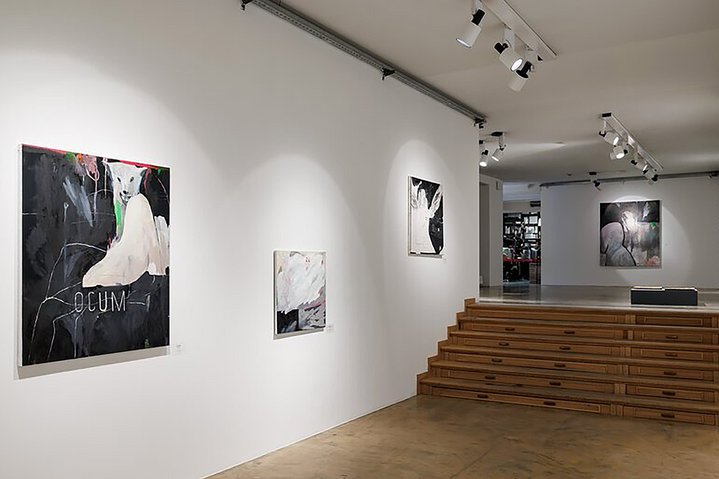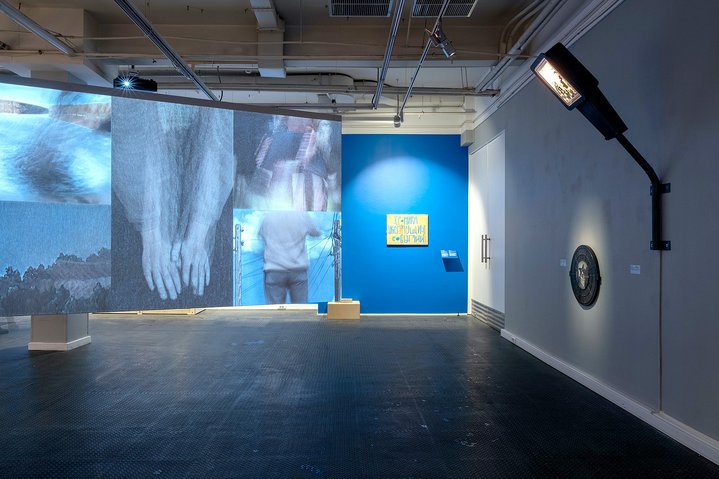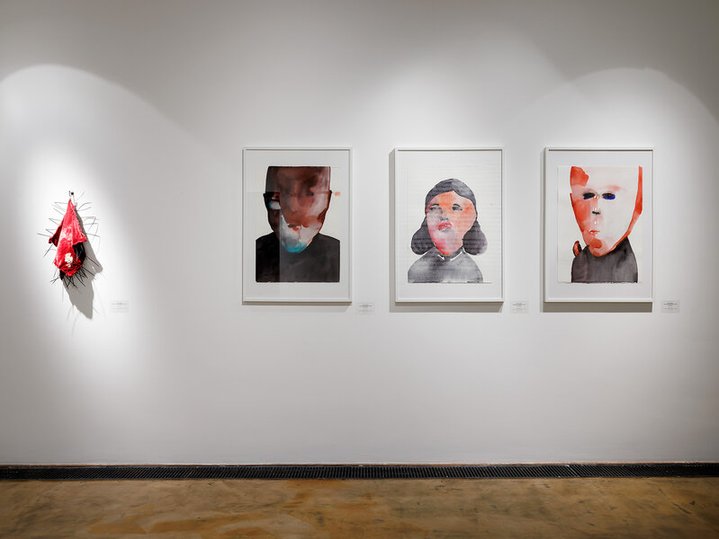A Chronicle of of Burgeoning Activity. Exhibition view. Moscow, 2024. Courtesy of Triumph Gallery
Nizhny Novgorod, Russia’s Capital of Street Art
Nizhny Novgorod’s street art and contemporary art scenes are thriving. From graffiti to graphite – this year it hosted Russia’s first ever contemporary art fair for works on paper - the city’s influence has been spreading further afield. Exhibitions in St. Petersburg and Moscow consisting of young art from the banks of the river Volga feel like a breath of fresh air.
If contemporary art in Russia finds itself rooted on inhospitable ground, in Nizhny Novgorod it is thriving today, leading to a sense that its artists are at the front of the latest artistic developments in the country. There are first-class art museums which have been recently updated; it is home to the Arsenal Centre for Contemporary Art, part of the Pushkin State Museum of Fine Arts. Independent associations and groups are active there, galleries such as leaders 9B and Futuro are pushing ahead and there are cutting edge art festivals. For the first time in Russia this year art patron Dmitry Volodin organised a contemporary art fair dedicated to works on paper called ‘Contour’.
The art scene in Nizhny Novgorod can be applauded for its diversity: there is something for every taste. There is a large-scale exhibition ‘Named by Vasari. Mannerism’ at the Arsenal, which consists of masterpieces of the 16th century juxtaposed with contemporary art. There is a solo retrospective of Erik Bulatov (b.1933), legendary artist of the unofficial art scene in the warehouses of the Nizhny Novgorod Art Museum. And those who prefer something more challenging and are not afraid of walking the streets in winter, can take a stroll around the old streets and abandoned places in the city in search of street art which was created during the festival ‘Mesto’.
You can see the influence of Nizhny Novgorod's thriving art scene in the Russian capitals. In St Petersburg, Marina Gisich gallery is hosting an exhibition by young Nizhny Novgorodian artist Nikita Pirumov (b. 2002). And in Moscow, at the Triumph Gallery until the end of January, there is a show dedicated to Nizhny Novgorod’s most recent artistic processes, ‘A Chronicle of Burgeoning Activity’ presenting millennial and emerging artists to the public. This elevated status it has won evidently comes off the back of a wave of street art in the 1980s which in many ways is still ongoing, with successive waves of new generations of artists. Diverse activities allow them to break into new, previously unexplored spheres of interaction with the viewer.
It was graffiti artists who sparked off street art in Nizhny, one the early pioneers being Alexander Shimanov aka Stan. Setting the street art agenda of the late 1990s and 2000s, Stan and his team organised festivals, published magazines, and even created a website, motivating others to work in a team-spirited and systematic way. Nizhny Novgorod´s topography itself is the perfect backdrop or ´blank canvas´ for its street art. The city is located at the confluence of the Oka and Volga rivers with the high Dyatlovy mountains, on which the historical centre is located, rising from the embankment with numerous wastelands, with concrete fences, abandoned 19th and 20th century industrial architecture like the Kuibyshevskaya Vodokachka, a water pumping station built in 1880. Bridges, walls of industrial buildings, courtyards and abandoned houses, all has been transformed into the surfaces of giant murals that were painted by several generations of Nizhny Novgorod residents. A walk around Nizhny is still perceived as a quest in search of unknown masterpieces.
Parallel to the activities of the old guard of graffiti writers, new figureheads arose working alongside them in the mid 2000s, such as Nikita Nomerz (b. 1990) and Artyom Filatov (b. 1991). In principle, it is these artists who today determine the direction of Nizhny Novgorod’s independent art scene. The street art festival ‘Mesto’ was founded by Nikita Nomerz, and Artyom Filatov is the director of an independent artists' workshop called ‘Tikhaya’ (The Quiet One), which has staged a large-scale show of young Nizhny Novgorod artists at the Triumph Gallery in Moscow.
Both Nomerz and Filatov have shifted the focus of street art from graffiti to autonomous art. Graffiti artists are team players and consider their tags and typographic compositions not as autonomous statements, but as occasions for communication and some kind of signalling systems adopted in marginalised communities. The ability to do something together, to ruthlessly overpaint what they have done, to supplement their messages with different inserts and pictures, is an essential feature of real graffiti artists, bequeathed by the black gangs of America in the 1920s.
But the urban art of the Nomerz era is predominantly that of street art. The principal difference between street art and graffiti is the autonomy of expression, defending the purely personal gesture of an artist. From the end of the noughties until the end of the 2010s complex compositions with intricate and exquisite graphics, masterly images of people, nature and genre scenes began to appear in Nizhny Novgorod. In his anatomical studies Nikita Nomerz turns to the academic style, as well as sketchy and vector graphics of web-punk design. Artyom Filatov makes variations on the theme of ancient atlases of nature and plants. On the facades of houses around the city, Andrey Olenev (b. 1993) brings fantastic worlds of Dutch Old Masters to life. Ivan Sery puts transparent bricks into the potholes of the city architecture, containing small puppet theatres with allegorical scenes from the life of Nizhny Novgorod residents. Such a visual feast has unwittingly turned Nizhny into something of an open-air museum. It is fascinating to stroll through the city. The abandoned water pumping station first became a Sistine Chapel of alternative art through the efforts Evgeny Strelkov (b. 1963) a graffiti master of the first generation, then came the TOY team, Anton Morokov (b. 1991), Yakov Khorev (b. 1991), Nikita Nomerz, Vova Chernyshev (b. 1992) and other younger artists who are leaving their mark.
Today street art in Nizhny Novgorod is perhaps predictably going through a new period of metamorphosis. It is becoming increasingly difficult to paint giant areas of the city’s old industrial architecture as the authorities do not allow it. Money is scarce. But a strong team spirit remains as does a unique hybrid style of painting, in which naive handwriting is intricately combined with neo baroque and post-digital emblems and symbols. With this style, one can paint a poignant self-portrait, with one’s personal problems, desires and happiness. Unsurprisingly, punk street style naturally fits into the walls of a gallery such as 9B and Futuro, and it sells well. The artists themselves have adjusted their ways of working to achieve greater professional complexity, perfectionism and precision – qualities that determine the success of easel paintings. In the mid-2010s, the Bomse Crew were radical marginal graffiti artists who often turned to the strategy of ‘bombing’, gestures that brought them into conflict with the infrastructure and their neighbours in street art. While continuing to make a living by making tattoos, the leaders of the Bomse Crew gradually began to develop a complex polyphonic style of art. It appeals to subcultural patterns, while at the same time it makes exquisite allusions to the complex calligraphic imagery of the ‘Gothic’ Romantics, from William Blake (1757–1827) and Henry Fuseli (1741–1825) to the Pre-Raphaelites. The extraordinary responsiveness of Bomse Crew's new art to both tradition and the youthful audience itself matched by its commercial success.
For me, the synthesis of different art strategies and a keen sensitivity to different audiences lies behind the triumph of Nizhny Novgorod's street art and, more broadly, its contemporary art, and crucially its future potential.
A Chronicle of Burgeoning Activity
Moscow, Russia
24 November 2023 – 21 January 2024
Nikita Pirumov. Backward Walking
St. Petersburg, Russia
8 December – 8 March 2024

















